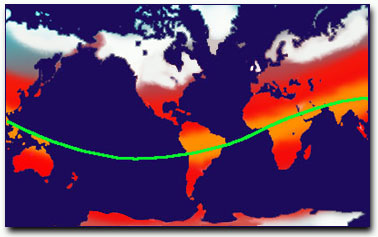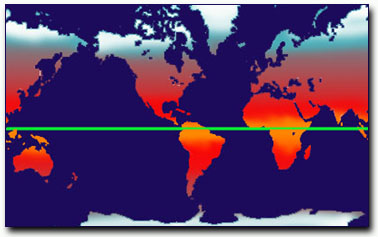
|
[continued] It was this "floating" of the Earth's crust that first sparked Hapgood's interest, and lead him to the ideas of Hugh Achincloss Brown. Brown had theorized that the entire earth could be made to be repositioned at a radically new angle on its axis of rotation. In other words, the Earth could change angle of its spin relative to the orbit around the Sun. Brown tried to use this argument to explain climatic changes, but his theory failed the test of mathematics. Brown's idea was not a new one. Some of the greatest geologists of the time, including J.C.Maxwell and Sir George Darwin (son of the famous Charles Darwin), considered this possibility, and decided that the stabilizing effect of the equatorial bulge was so great that no conceivable force originating within the Earth could make it shift on its axis, except for the collision with another planet. They, therefore, dismissed the idea of any shift of the poles as impossible and, in fact, not worth discussing. Their influence has been so pervasive that, to this day, no one has seriously considered such an hypothesis. Hapgood, too, accepted the assumption that only a planetary collision is capable of displacing the axis of rotation. He proposed a theory that explained the shift of the poles as the result of the shift of the whole Earth's crust. The disturbances needed to slide the Earth's crust were far less than those needed to tilt the entire planet-- core and all. Based on the research of the Russian scientist V.V. Beloussov, he assumed that at a depth of a hundred miles or so, in the upper mantle, there is a layer of liquid rock (magma) which behaves as a bearing, allowing the whole crust to shift when subjected to a displacing force. In Hapgood's opinion, this force is provided by the centrifugal momentum of ice caps eccentric to the poles. In other words, the weight of the ice on the poles is off-balancing the Earth's own daily rotation. Eventually, this imbalance gets to the point where a change occurs. According to Hapgood, the Earth keeps its axis of rotation unchanged, but the poles, and the whole Earth's surface, slide and change latitude. For a while, the Earth is balanced. Hapgood realized that the entire planet did not need to be repositioned around its axis to maintain its balance. Only the outer crust needed to move, just as the loosely peeled skin of an orange (or avocado) could be slid around the stationary inner fruit. This line of thinking was published in Earth's Shifting Crust, in collaboration with James H. Campbell, a mathematician-engineer. Hapgood then proposed looking for Atlantis in a place where no one had ever suspected-- Antarctica. Hapgoods reasoning went like this: He envisioned a catastrophic and dramatic move of the entire skin which allowed thick polar ice caps to melt in their new, warmer climate. Ice would again began to build up at the new poles, awaiting the next shift. In this scenario, Atlantis was repositioned to become a frozen and inhospitable continent, while the changing ocean levels reflected the amount of water locked up in the form of ice. Since Plato's Atlantis was in the center of "the great ocean," Hapgood summarized that Antarctica would have been a perfect candidate for the lost continent, especially if it had it once been in a more Northern and moderate climate. Moreover, the legends of a catastrophic end to this advanced civilization could be descriptive of an abrupt continental slippage. If this is true, then we might well find our long lost mariners and mathematicians under the kilometers of ice that now cover the South Pole.
The evidence proving that the poles where in different positions during the Pleistocene era is quite impressive, and this explains why Hapgood's theory was approved by scientists such as Einstein and K.F. Mather. But his theory meets with so many difficulties that it beomes highly controversial. Above all, it seems to conflict with widely accepted theories, such as the drift of the continents. Hapgood, while credited with plotting the positions of past polar coordinates, was forced to adhere to a much slower transition of the poles, accepting the paradigm of continental drift and plate tectonics to maintain the support of the scientific community. Ironically, one of the most recent objections to Hapgood's theory is the rapidity of climate changes that occurred in the Pleistocene period. According to Hapgood's revised theory, it took the North Pole at least two thousand years to move from its previous position to the present. The evidence we now have, however, definitely points to much faster climatic changes. It was Hapgood himself who first underscored the enormous amount of evidence proving the high speed at which the shift of the poles appears to have happened; speed which the mechanism of continental drift is unable to explain. The only way to completely and coherently explain what took place at the end of Pleistocene appears to be that of admitting the possibility of a shift of the poles of the same magnitude Hapgood hypothesizes, but in a much shorter time: not more than a few days! This possibility is openly refused, only because no convincing explanation has been forwarded so far. It would, however, support the abrupt disaster the befell Atlantis-- if it is under Antarctica's polar ice cap. With no hard data to explain this extremely abrupt disturbance in geography, Hapgood continued aligned with the theory of a gradual shift. In the forward to a book on the subject, Hapgood wrote: "Polar wandering is based on the idea that the outer shell of the earth shifts about from time to time, moving some continents toward and other continents away from the poles. Continental drift is based on the idea that the continents move individually... A few writers have suggested that perhaps continental drift causes polar wandering. This book advances the notion that polar wandering is primary and causes the displacement of continents.... This book will present evidence that the last shift of the earth's crust (the lithosphere) took place in recent time, at the close of the last ice age, and that it was the cause of the improvement in climate." 
Based primarily on accepted, technical data, Hapgood argued that each shift took approximately 5,000 years, followed by 20,000 to 30,000 year periods with no polar movements. Also, in his calculations, the area of movement never covered more than 40 degrees.
Using geomagnetic and carbon dating evidence, he identified the
locations of the pole and its paths.
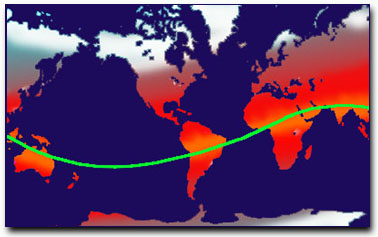
Position #1 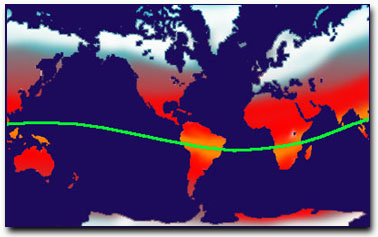
Position #2
Position #3
Position #4 If the poles shift even as little (within 40 degrees) as Hapgood argues, then the equator moves in significant ways. (This is shown by the green lines on the familiar maps the globe, above). This line traces the equator for each of the past polar positions. Notice the effects such polar shifts would have upon climate for various regions of the world. The changes in position are especially noticeable by where the equator cuts across the African continent in each situation-- high, diagonally or low, compared to today.
Some supportive historical facts were given by Hapgood to support these shifts in continental position and climate:
So, while debate continues on the speed at which the poles have changed, the fact of their shift seems well established. It also appears that the shift will continue, as it likely has for millennia, as part of a cycle we are just now beginning to understand. UPDATE 2010:
Earth's north magnetic pole racing towards Russia due to core flux
Washington, December 25 : A new research has determined that Earth's north magnetic pole is racing toward Russia at almost 40 miles (64 kilometers) a year due to magnetic changes in the planet's core.
The core is too deep for scientists to directly detect its magnetic field. But researchers can infer the field's movements by tracking how Earth's magnetic field has been changing at the surface and in space.
Now, according to a report in National Geographic News, newly analyzed data suggest that there's a region of rapidly changing magnetism on the core's surface, possibly being created by a mysterious 'plume' of magnetism arising from deeper in the core.
'It's this region that could be pulling the magnetic pole away from its long-time location in northern Canada,' said Arnaud Chulliat, a geophysicist at the Institut de Physique du Globe de Paris in France.
Magnetic north, which is the place where compass
needles actually point, is near but not exactly in the same place as the geographic North Pole.
Right now, magnetic north is close to Canada's Ellesmere Island.
Navigators have used magnetic north for centuries to orient themselves when they are far from recognizable landmarks.
Although global positioning systems have largely replaced such traditional techniques, many people still find compasses useful for getting around underwater and underground where GPS satellites can't communicate.
The magnetic north pole had moved little from the time scientists first located it in 1831.
Then in 1904, the pole began shifting northeastward at a steady pace of about 9 miles (15 kilometers) a year.
In 1989 it sped up again, and in 2007 scientists confirmed that the pole is now galloping toward Siberia at 34 to 37 miles (55 to 60 kilometers) a year.
A rapidly shifting magnetic pole means that magnetic-field maps need to be updated more often to allow compass users to make the crucial adjustment from magnetic north to true North.
Geologists think Earth has a magnetic field because the core is made up of a solid iron center surrounded by rapidly spinning liquid rock.
This creates a 'dynamo' that drives our magnetic field.
Scientists had long suspected that, since the molten core is constantly moving, changes in its magnetism might be affecting the surface location of magnetic north.
Although the new research seems to back up this idea, Chulliat is skeptical whether magnetic north will eventually cross into Russia.
'It's too difficult to forecast,' Chulliat said.
Comments:
Hapgood makes some great arguments, however, I feel it would take some outside
force or disruption of our planet to cause a polar or crustal shift. There is no
telling what lurks out in the darkness of space outside our solar system and
heading our way. Robert Napier
The geological and paleontological evidence presented by Hapgood is just too good a fit to discount.
As I recall, in the 60s the concept of plate-tectonics was just as controversial .
His theory allows for both crust shift and plate-technonics.
There's really no reason not to accept Hapgood's theory as possible and simply suggest , as Einstein did, further search for the force that causes the periodic crust shift.
Personally, I feel so little is known about composition of the inner earth) that an internal force, or a tidal interaction betwen sun, earth and moon are more likely than an extra-solar system cause.
However, the gravitational forces of a periodic large mass fly by could fit the bill.
My view is that we might as well accept crustal shift.
We have maybe 10,000 years to figure it out.
That said, we have energy resource constraints, mass migration, and environmental-change issues that confront us in the next decades!
Brian I've always been facinated by the theory of polar slide/polar shift/polar drift and I'm sure many more people will be after this new movie (2012) comes out. There are a few which actually look possibe and Mr. Hopgood's theory is one of the ones that stands out best. It takes into consideration climate change with movement of polar ice caps. Even looking at ancient maps, we can see Antartica was not always completely covered by polar ice; so his theory seems sound.
I like how he also looks for outside factor such as meteor collision to explain such factors. I would like to offer another such factor to help with understanding polar shift and the possiblilty of why it happens. How about magnetics? We do ride on a great big electro-magnetic generator. So considering this how many other things in this galaxy of ours have a magnetic charge? Other planets? The do spin as well with the same basic makeup of our planet, however, some are only gasses. The makeup of our planet is molten metals revolving around a lead core making it much stronger then others that are made up of gasses.
So again, this large electro-magnetic generator (which is polarized) might look for outside attractors and magnetic pull can be a very strong attractor. So what can we look for? Well, anything in space can be seen to have an EM field on it. So what polarization are things like Jupiter? Haley's Comet? Our local fussion generator Sol (our sun)? Black holes? The super black hole at the center of the galaxy? What else in this galaxy is polarized?
Let's say we take a table and put two magnets on it. We call one earth and another "outside attractor". If we were to move the magnets close enough to each other to affect one another, we could manipulate one magnet with the other. By pushing the north end of "outside attractor" toward the north end of earth, or vice versa, we could move it slightly. Now let's put a nail or screw through the center of earth to represent the sun's gravity which keeps us in orbit and you see a drastic difference in the movement of that magnet.
For arguement's sake, let's say we pass kinda close, say a couple of light years, from a pulsar that is generating positive (north) and our south pole is attracted? Could this not cause the pole to shift slightly? Or perhaps we move a little too close (again, a couple of light years) to a negative charged black hole. Wouldn't that push the south pole away like in the same manner of the magnets?
Really, these are just the thoughts of someone who works with electricity and understand how some electro-magnetics work. Noone of real importance and certainly not a great mind of our time. However, just offering a theory and something for those who read this to think about.
JD Glenn III
|
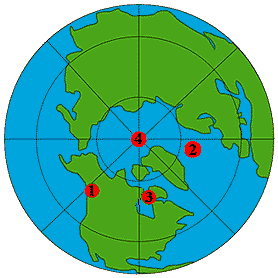 Looking down on the current North Pole, we can identify
at least 3 previous positions of the pole according to Hapgood.
These are shown roughly by the numbered red dots.
Looking down on the current North Pole, we can identify
at least 3 previous positions of the pole according to Hapgood.
These are shown roughly by the numbered red dots. 